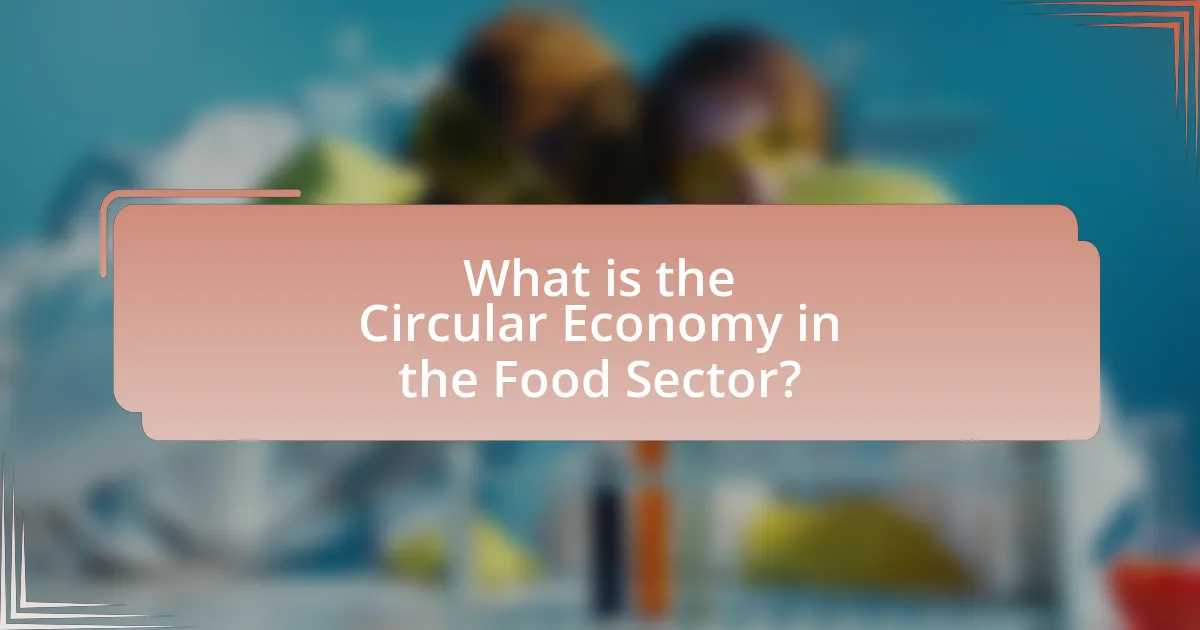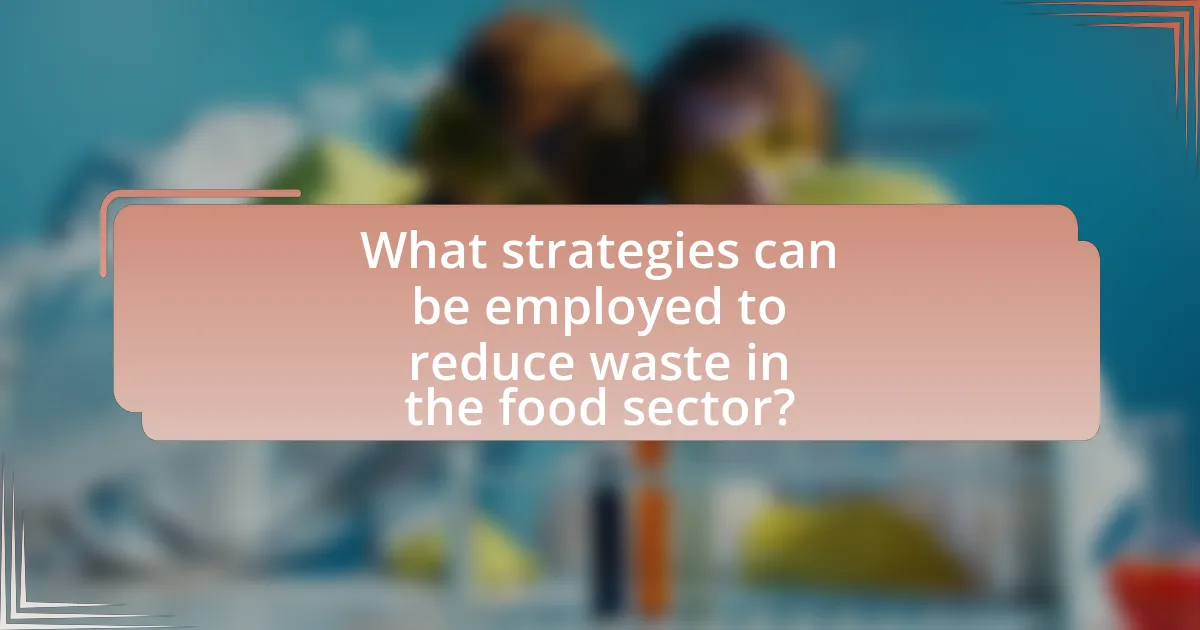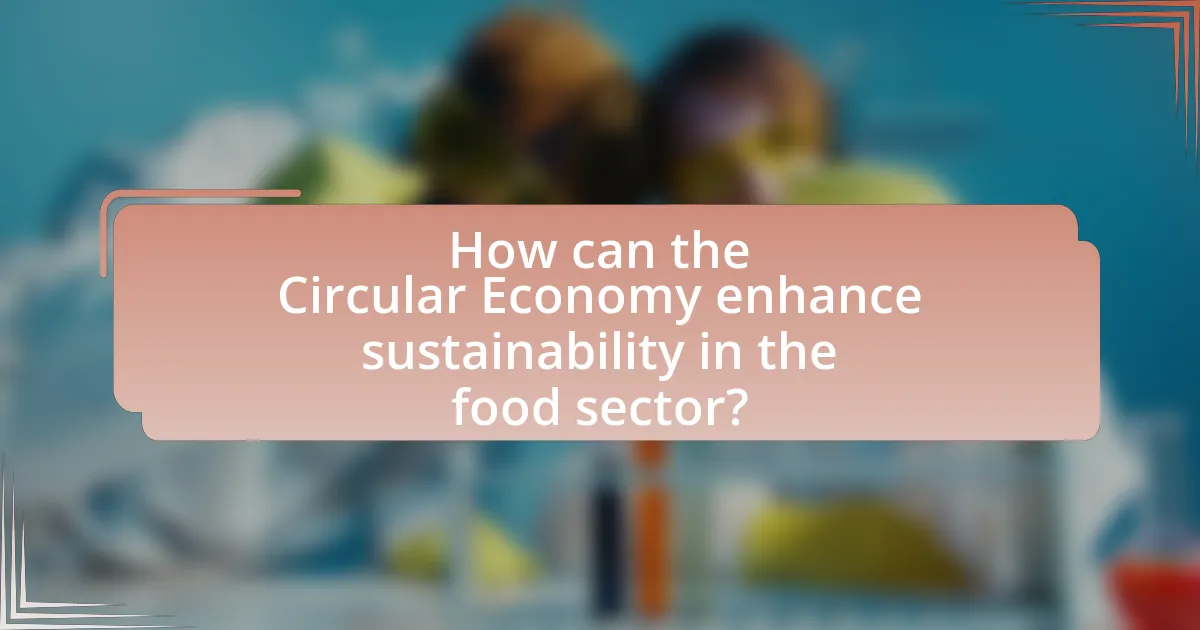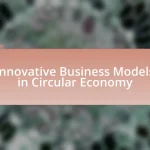The Circular Economy in the Food Sector is an economic model designed to minimize waste and optimize resource use through closed-loop systems. This approach emphasizes the reuse, recycling, and recovery of materials throughout the food supply chain, significantly reducing food waste and greenhouse gas emissions. Key principles include reducing waste, reusing resources, and sustainable sourcing, which collectively enhance sustainability and resource efficiency. The article also addresses the environmental impacts of traditional food systems, the challenges of implementing circular practices, and the role of stakeholders, including consumers and governments, in promoting a more sustainable food system.

What is the Circular Economy in the Food Sector?
The Circular Economy in the Food Sector is an economic model that aims to minimize waste and make the most of resources by creating closed-loop systems. This approach emphasizes the reuse, recycling, and recovery of materials throughout the food supply chain, from production to consumption and disposal. For instance, food waste can be transformed into compost or energy, thereby reducing landfill contributions and enhancing soil health. According to the Ellen MacArthur Foundation, transitioning to a circular economy in food could reduce greenhouse gas emissions by up to 70% by 2050, demonstrating its potential for significant environmental impact.
How does the Circular Economy differ from traditional food systems?
The Circular Economy differs from traditional food systems by emphasizing resource regeneration and waste reduction throughout the food supply chain. In traditional food systems, a linear model is followed where resources are extracted, used, and disposed of, leading to significant waste and environmental degradation. In contrast, the Circular Economy promotes practices such as recycling, composting, and sustainable sourcing, aiming to close the loop on resource use. For example, according to the Ellen MacArthur Foundation, implementing circular principles in food systems can reduce food waste by up to 50%, thereby enhancing sustainability and resource efficiency.
What are the key principles of the Circular Economy in food?
The key principles of the Circular Economy in food include reducing waste, reusing resources, and recycling materials to create a sustainable food system. These principles aim to minimize the environmental impact of food production and consumption by promoting practices such as composting organic waste, utilizing by-products in food processing, and designing products for longevity and recyclability. For instance, the Ellen MacArthur Foundation emphasizes that transitioning to a circular food economy can significantly reduce greenhouse gas emissions and resource depletion, supporting a more sustainable future for food systems.
How does the Circular Economy address food waste?
The Circular Economy addresses food waste by promoting the reuse, recycling, and recovery of food products and materials, thereby minimizing waste generation. This approach encourages practices such as composting organic waste, redistributing surplus food to those in need, and transforming food by-products into new products, which can significantly reduce the amount of food that ends up in landfills. According to the Food and Agriculture Organization, approximately one-third of all food produced globally is wasted, highlighting the urgent need for systems that prioritize sustainability and resource efficiency. By implementing circular economy principles, businesses and consumers can create a more sustainable food system that not only reduces waste but also enhances food security and resource conservation.
Why is the Circular Economy important for sustainability in the food sector?
The Circular Economy is important for sustainability in the food sector because it minimizes waste and promotes resource efficiency. By reusing materials and reducing the reliance on finite resources, the Circular Economy helps to create a closed-loop system where food production, consumption, and waste management are interconnected. For instance, according to the Ellen MacArthur Foundation, transitioning to a Circular Economy in food could reduce greenhouse gas emissions by up to 70% by 2050. This approach not only conserves natural resources but also enhances food security by ensuring that food systems are resilient and sustainable over time.
What environmental impacts does the food sector have?
The food sector has significant environmental impacts, primarily through greenhouse gas emissions, land use change, and water consumption. Agriculture contributes approximately 24% of global greenhouse gas emissions, largely due to methane from livestock and nitrous oxide from fertilizers. Additionally, the sector is responsible for deforestation and habitat loss, as land is converted for crop production and livestock grazing, which affects biodiversity. Water usage is also critical, with agriculture accounting for about 70% of freshwater withdrawals globally, leading to water scarcity in many regions. These factors collectively highlight the food sector’s substantial environmental footprint.
How can the Circular Economy mitigate these impacts?
The Circular Economy can mitigate impacts in the food sector by promoting resource efficiency and waste reduction through practices such as recycling, composting, and sustainable sourcing. By implementing these practices, food businesses can minimize waste generation, reduce greenhouse gas emissions, and conserve natural resources. For instance, a study by the Ellen MacArthur Foundation highlights that transitioning to a Circular Economy in the food sector could reduce food waste by 50% by 2030, significantly lowering environmental impacts. This approach not only enhances sustainability but also creates economic opportunities by fostering innovation in food production and distribution systems.
What are the main challenges in implementing a Circular Economy in the food sector?
The main challenges in implementing a Circular Economy in the food sector include logistical complexities, consumer behavior, and regulatory frameworks. Logistical complexities arise from the need to redesign supply chains to minimize waste and enhance resource recovery, which can be costly and time-consuming. Consumer behavior poses a challenge as many individuals are resistant to changing their purchasing habits or may lack awareness of sustainable practices. Regulatory frameworks often do not support circular initiatives, as existing policies may favor linear economic models, creating barriers for businesses attempting to adopt circular practices. These challenges hinder the transition towards a more sustainable food system.
What barriers do businesses face in adopting Circular Economy practices?
Businesses face several barriers in adopting Circular Economy practices, including high initial investment costs, lack of consumer awareness, and insufficient regulatory support. High initial investment costs deter many companies from transitioning to circular models, as they often require significant financial resources for new technologies and processes. Additionally, a lack of consumer awareness about the benefits of circular practices can limit demand for sustainable products, making it challenging for businesses to justify the shift. Furthermore, insufficient regulatory support can create uncertainty, as businesses may hesitate to invest in circular initiatives without clear guidelines or incentives from governments. These barriers collectively hinder the widespread adoption of Circular Economy practices in the food sector.
How can consumer behavior affect the success of the Circular Economy?
Consumer behavior significantly affects the success of the Circular Economy by influencing demand for sustainable products and practices. When consumers prioritize eco-friendly options, businesses are incentivized to adopt circular practices, such as reducing waste and enhancing resource efficiency. For instance, a study by the Ellen MacArthur Foundation indicates that consumer preferences for sustainable products can lead to a 30% increase in sales for companies that implement circular strategies. This shift in consumer behavior not only drives market trends but also encourages innovation in sustainable practices, ultimately contributing to the overall effectiveness of the Circular Economy in sectors like food, where reducing waste is critical for sustainability.

What strategies can be employed to reduce waste in the food sector?
Implementing strategies such as improving supply chain efficiency, enhancing food recovery programs, and promoting consumer education can significantly reduce waste in the food sector. Improving supply chain efficiency involves optimizing logistics and inventory management to minimize overproduction and spoilage, which accounts for approximately 30% of food waste globally. Food recovery programs, such as partnerships with food banks and charities, can redirect surplus food to those in need, reducing waste while addressing food insecurity. Additionally, consumer education initiatives that inform individuals about proper food storage, meal planning, and expiration dates can empower consumers to make informed choices, ultimately decreasing household food waste, which represents about 61% of total food waste in the United States.
How can food producers minimize waste through Circular Economy practices?
Food producers can minimize waste through Circular Economy practices by implementing strategies such as resource recovery, waste valorization, and sustainable sourcing. These practices involve reusing by-products, converting waste into valuable materials, and optimizing supply chains to reduce excess. For instance, a study by the Ellen MacArthur Foundation highlights that adopting circular principles can lead to a 50% reduction in food waste across the supply chain. By focusing on these methods, food producers can enhance sustainability while also improving economic efficiency.
What role does food processing play in waste reduction?
Food processing plays a crucial role in waste reduction by transforming raw ingredients into value-added products, thereby minimizing spoilage and maximizing resource efficiency. Through techniques such as canning, freezing, and drying, food processing extends the shelf life of perishable items, reducing the likelihood of food waste. For instance, the Food and Agriculture Organization (FAO) estimates that approximately one-third of food produced globally is wasted, highlighting the importance of processing methods that can help mitigate this issue. Additionally, food processing can utilize by-products and waste materials to create new products, further contributing to a circular economy by ensuring that resources are not discarded but repurposed effectively.
How can packaging innovations contribute to waste reduction?
Packaging innovations can significantly contribute to waste reduction by utilizing materials that are biodegradable, recyclable, or reusable. For instance, the development of compostable packaging made from plant-based materials can reduce landfill waste, as these materials break down naturally. According to a study by the Ellen MacArthur Foundation, transitioning to biodegradable packaging could reduce plastic waste by up to 80% in certain applications. Additionally, innovations such as minimalistic packaging designs and concentrated product formulations can decrease the amount of material used, further lowering waste generation. These advancements not only enhance sustainability in the food sector but also align with circular economy principles by promoting resource efficiency and reducing environmental impact.
What are effective waste management techniques in the food sector?
Effective waste management techniques in the food sector include source reduction, composting, anaerobic digestion, and food donation. Source reduction focuses on minimizing waste generation at the outset by optimizing production processes and inventory management, which can significantly decrease the volume of food waste. Composting converts organic waste into nutrient-rich soil amendments, thereby diverting waste from landfills and enhancing soil health. Anaerobic digestion processes organic materials to produce biogas, which can be used for energy, while also reducing methane emissions from landfills. Food donation programs facilitate the redistribution of surplus food to those in need, effectively reducing waste and addressing food insecurity. These techniques collectively contribute to a circular economy by promoting sustainability and resource efficiency in the food sector.
How can composting and recycling be integrated into food systems?
Composting and recycling can be integrated into food systems by establishing systems that convert organic waste into valuable resources, thereby closing the nutrient loop. Food producers can implement composting practices to process food scraps and agricultural residues, which can then be used to enrich soil, enhancing crop yields and reducing the need for chemical fertilizers. Additionally, recycling initiatives can focus on repurposing packaging materials and other non-organic waste generated during food production and distribution. For instance, the Food Waste Reduction Toolkit by the USDA emphasizes the importance of composting and recycling in minimizing food waste and promoting sustainable practices within the food sector. This integration not only reduces landfill contributions but also supports a circular economy by returning nutrients to the soil and conserving resources.
What technologies are available for waste tracking and management?
Technologies available for waste tracking and management include RFID (Radio Frequency Identification), IoT (Internet of Things) sensors, mobile applications, and blockchain technology. RFID technology enables real-time tracking of waste containers, improving inventory management and reducing loss. IoT sensors monitor waste levels and provide data analytics for optimizing collection routes and schedules. Mobile applications facilitate user engagement by allowing consumers and businesses to report waste generation and disposal practices. Blockchain technology enhances transparency and traceability in waste management processes, ensuring accountability and compliance with regulations. These technologies collectively contribute to more efficient waste management practices, supporting sustainability efforts in the food sector.

How can the Circular Economy enhance sustainability in the food sector?
The Circular Economy enhances sustainability in the food sector by promoting resource efficiency and waste reduction through closed-loop systems. This approach minimizes food waste by reusing by-products, such as converting food scraps into compost or animal feed, thereby reducing landfill contributions and greenhouse gas emissions. For instance, the Food and Agriculture Organization (FAO) estimates that one-third of food produced globally is wasted, which could be significantly reduced through circular practices. Additionally, implementing sustainable sourcing and production methods, such as regenerative agriculture, supports biodiversity and soil health, further contributing to environmental sustainability.
What are the benefits of sustainable sourcing in the Circular Economy?
Sustainable sourcing in the Circular Economy offers multiple benefits, including reduced environmental impact, enhanced resource efficiency, and improved economic resilience. By prioritizing materials that are renewable, recyclable, or biodegradable, businesses can minimize waste and lower carbon emissions, contributing to a healthier ecosystem. For instance, a study by the Ellen MacArthur Foundation highlights that transitioning to sustainable sourcing can lead to a 70% reduction in greenhouse gas emissions in the food sector. Additionally, sustainable sourcing fosters innovation and creates new market opportunities, as companies that adopt these practices often gain a competitive edge and attract environmentally conscious consumers.
How does local sourcing impact sustainability?
Local sourcing significantly enhances sustainability by reducing transportation emissions and supporting local economies. When food is sourced locally, the distance it travels from farm to table is minimized, which decreases greenhouse gas emissions associated with transportation. According to a study by the USDA, local food systems can reduce carbon footprints by up to 25% compared to conventional supply chains. Additionally, local sourcing fosters economic resilience by keeping money within the community, which can lead to increased investment in sustainable practices and local environmental stewardship. This interconnectedness between local sourcing and sustainability is crucial for promoting a circular economy in the food sector.
What are the advantages of seasonal eating in a Circular Economy?
Seasonal eating in a Circular Economy promotes sustainability by reducing food waste and minimizing carbon footprints. By consuming locally grown, seasonal produce, consumers support local farmers, which decreases transportation emissions and encourages biodiversity. Research indicates that seasonal foods are often fresher and more nutrient-dense, enhancing health benefits. Additionally, this practice fosters a connection between consumers and their food sources, leading to more mindful consumption patterns. The European Commission reports that local food systems can reduce greenhouse gas emissions by up to 30%, highlighting the environmental advantages of seasonal eating within a Circular Economy framework.
How can collaboration among stakeholders improve sustainability?
Collaboration among stakeholders can significantly improve sustainability by fostering shared resources, knowledge, and practices that enhance efficiency and reduce waste. When stakeholders such as producers, consumers, and policymakers work together, they can create integrated systems that optimize resource use and minimize environmental impact. For instance, a study by the Ellen MacArthur Foundation highlights that collaborative efforts in the food sector can lead to a 50% reduction in food waste, demonstrating the tangible benefits of stakeholder engagement in sustainability initiatives.
What roles do governments play in promoting Circular Economy practices?
Governments play a crucial role in promoting Circular Economy practices by implementing policies, regulations, and incentives that encourage sustainable resource management. They establish legal frameworks that support waste reduction, recycling, and the use of renewable resources, which are essential for transitioning to a Circular Economy. For instance, the European Union’s Circular Economy Action Plan aims to make sustainable products the norm, thereby reducing waste and promoting resource efficiency across various sectors, including food. Additionally, governments can provide financial incentives, such as grants or tax breaks, to businesses that adopt Circular Economy practices, further driving innovation and sustainability in the food sector.
How can consumers contribute to a more sustainable food system?
Consumers can contribute to a more sustainable food system by choosing to buy locally sourced and seasonal foods. This practice reduces transportation emissions and supports local economies, which is essential for a circular economy. According to a study by the Food and Agriculture Organization, local food systems can decrease greenhouse gas emissions by up to 30% compared to conventional supply chains. Additionally, consumers can minimize food waste by planning meals, using leftovers creatively, and composting organic waste, which further enhances sustainability by returning nutrients to the soil.
What are some best practices for implementing Circular Economy principles in the food sector?
Best practices for implementing Circular Economy principles in the food sector include reducing food waste, enhancing resource efficiency, and promoting sustainable sourcing. Reducing food waste can be achieved through better inventory management and consumer education, which can lower the estimated one-third of food produced that is wasted globally. Enhancing resource efficiency involves optimizing production processes and utilizing by-products, such as converting food scraps into compost or animal feed, which can minimize environmental impact. Promoting sustainable sourcing encourages the use of local and seasonal ingredients, reducing transportation emissions and supporting local economies. These practices collectively contribute to a more sustainable food system, aligning with Circular Economy goals.
How can businesses measure their sustainability efforts?
Businesses can measure their sustainability efforts through key performance indicators (KPIs) that assess environmental impact, resource efficiency, and social responsibility. These KPIs can include metrics such as carbon footprint, water usage, waste generation, and energy consumption, which provide quantifiable data on a company’s sustainability practices. For instance, a study by the Global Reporting Initiative indicates that organizations using standardized sustainability reporting frameworks, such as the GRI Standards, can effectively track and communicate their sustainability performance, leading to improved transparency and accountability.
What resources are available for companies looking to transition to a Circular Economy?
Companies looking to transition to a Circular Economy can access various resources, including guidelines from the Ellen MacArthur Foundation, which provides frameworks and case studies on circular practices. Additionally, the World Economic Forum offers insights and tools for implementing circular strategies in business operations. The Circular Economy Toolkit, developed by the University of Cambridge, serves as a practical resource for businesses to assess their current practices and identify opportunities for circularity. Furthermore, industry-specific organizations, such as the Food Waste Reduction Alliance, provide tailored resources and best practices for the food sector, emphasizing waste reduction and sustainability. These resources collectively support companies in adopting circular economy principles effectively.


